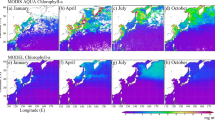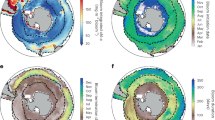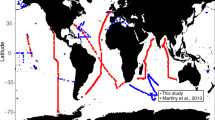Abstract
Time-series of chlorophyll-a (CHL), a proxy for phytoplankton biomass, and various satellite-derived climate indicators are compared in a region of the Subantarctic Southern Ocean (40°−60°S, 110°−140°E) for years 2012−2014. CHL reached a minimum in winter (June) and a maximum in late summer (early February). Zonal mean CHL decreased towards the south. Mean sea surface temperature (SST) ranged between 8℃ and 15℃ and peaked in late February. CHL and SST were positively correlated from March to June, negatively correlated from July to September. CHL and wind speed (WIND) were negatively correlated with peak WIND occurred in winter. Wind direction (WIRD) was mostly in the southwest to westerly direction. The Antarctic Oscillation index (AAO) and CHL were negatively correlated (R = −0.58), indicating that as synoptic wind systems move southwards, CHL increases, and conversely when wind systems move northwards, CHL decreases. A genetic algorithm is used to calibrate the biogeochemical DMS model’s key parameters. Under 4 × CO2 (after year 2100) Regional mean SST increases 12%−17%, WIND increases 1.2 m s−1, Cloud Cover increases 4.8% and mixed layer depth (MLD) decreases 48m. The annual CHL increases 6.3%. The annual mean DMS flux increase 25.2%, increases 37% from day 1 to day 280 and decrease 3% from day 288 to day 360. The general increase of DMS flux under 4 × CO2 conditions indicates the Subantarctic regional climate would be affected by changes in the DMS flux, with the potential for a cooling effect in the austral summer and autumn.
Similar content being viewed by others
References
Banse, K., 1996. Low seasonality of low concentrations of surface chlorophyll in the subantarctic water ring: Underwater irradiance, iron, or grazing? Progress in Oceanography, 37: 241–291.
Barker, P. F., Filippelli, G. M., Florindo, F., Martin, E. E., and Scher, H. D., 2007. Onset and role of the Antarctic Circumpolar Current. Deep Sea Research Part II: Topical Studies in Oceanography, 54: 2388–2398.
Bowie, A. R., Brian Griffiths, F., Dehairs, F., and Trull, T. W., 2011. Oceanography of the subantarctic and polar frontal zones south of Australia during summer: Setting for the SAZsense study. Deep Sea Research Part II: Topical Studies in Oceanography, 58: 2059–2070.
Boyer, T. P. A. S. L., 1994. Quality control and processing of historical temperature, salinity and oxygen data. NOAA Technical Report NESDIS 81.
Fitch, D. T., and More, J. K., 2007. Wind speed influence on phytoplankton bloom dynamics in the Southern Ocean Marginal Ice Zone. Journal of Geophysical Research, 112 (C8): C08006.
Frölicher, T. L., Sarmiento, J. L., Paynter, D. J., Dunne, J. P., Krasting, J. P., and Winton, M., 2015. Dominance of the Southern Ocean in anthropogenic carbon and heat uptake in CMIP5 Models. Journal of Climate, 28: 862–886.
Gabric, A. J., Ayers, G. P., and Sander, A. G. C., 1995. Independent marine and atmospheric model estimates of the sea-air flux of dimethylsulfide in the Southern Ocean. Geophysical Research Letters, 22: 3521–3524.
Gabric, A. J., Cropp, R., Hirst, T., and Marchant, H., 2003. The sensitivity of dimethyl sulfide producion to simulated climate change in the Eastern Antarctic Southern Ocean. Tellus, 55: 966–981.
Gabric, A. J., Matrai, P. A., and Vernet, M., 1999. Modelling the production and cycling of dimethylsulphide during the vernal bloom in the Barnents Sea. Tellus, 51B: 919–937.
Gabric, A. J., Whetton, P. H., Boers, R., and Ayers, G. P., 1998. The impact of simulated climate change on the air-sea flux of dimethylsulphide in the subantarctic Southern Ocean. Tellus, 50: 388–399.
Jarnikova, T., and Tortell, P. D., 2016. Towards a revised climatology of summertime dimethylsulfide concentrations and sea-air fluxes in the Southern Ocean. Environmental Chemistry, 13: 364–378.
Kloster, S., Feichter, J., Maier-Reimer, E., Six, K. D., Stier, P., and Wetzel, P., 2006. DMS cycle in the marine ocean-atmosphere system–A global model study. Biogeosciences, 3 (1): 29–51.
Leck, C., and Bigg, E. K., 2005. Biogenic particles in the surface microlayer and overlaying atmosphere in the central Arctic Ocean during summer. Tellus B, 57: 305–316.
Liss, P. S., and Merlivat, L., 1986. Air-Sea Gas Exchange Rates: Introduction and Synthesis. Springer, Netherlands, 113–127.
Liu, X., Wang, J., Cheng, X., and Yan, T., 2012. The temporal and spatial evolution of chlorophyll-a concentration in the South China. Journal of Tropical Oceanography, 31: 42–48.
Manabe, S., Stouffer, R. J., Spelman, M. J., and Bryan, K., 1991. Transient responses of a coupled ocean-atmosphere model to gradual changes of atmospheric CO2. Part I. Annual mean response. Journal of Climate, 4: 785–818.
Mikaloff Fletcher, S. E., Gruber, N., Jacobson, A. R., Doney, S. C., Dutkiewicz, S., Gerber, M., Follows, M., Joos, F., Lindsay, K., Menemenlis, D., Mouchet, A., M Ller, S. A., and Sarmiento, J. L., 2006. Inverse estimates of anthropogenic CO2 uptake, transport, and storage by the ocean. Global Biogeochemical Cycles, 20: GB2002.
Miller, C. B., 2004. Biological Oceanography. Blackwell Publishing, London, 1–43.
Montes-Hugo, M. A., and Yuan, X., 2012. Climate patterns and phytoplankton dynamics in Antarctic latent heat polynyas. Journal of Geophysical Research: Oceans, 117: 1–4.
O’hara, T. D., Rowden, A. A., and Williams, A., 2008. Coldwater coral habitats on seamounts: Do they have a specialist fauna? Diversity and Distributions, 14: 925–934.
Pang, H., 2006. Econometrics. Science Press, Beijing, 1–20.
Purkey, S. G., and Johnson, G. C., 2012. Global contraction of Antarctic Bottom Water between the 1980s and 2000s. Journal of Climate, 25: 5830–5844.
Qu, B., Gabric, A. J., Zeng, M., and Lu, Z., 2016. Dimethylsulfide model calibration in the Barents Sea using a genetic algorithm and neural network. Environmental Chemistry, 13: 413–424.
Qu, B., Gabric, A. J., Zeng, M., Xi, J., Jiang, L., and Zhao, L., 2017. Dimethylsulfide model calibration and parametric sensitivity analysis for the Greenland Sea. Polar Science, 13: 13–22.
Qu, B., Gabric, A. J., Zhao, L., Sun, W., Li, H., Gu, P., and Zeng, M., 2018. The relationships among aerosol optical depth, ice, phytoplankton and dimethylsulfide and the implication for future climate in the Greenland Sea. Acta Oceanologica Sinica, 37: 13–21.
Rintoul, S. R., and Trull, T. W., 2001. Seasonal evolution of the mixed layer in the subantarctic zone south of Australia. Journal of Geophysical Research, 106: 31447–31462.
Sall, E., Speer, J. B., and Morrow, A. R., 2008. Southern Ocean fronts and their variability to climate modes. Journal of Climate, 21: 3020–3039.
Sim, R., 2001. Production of atmospheric sulfur by oceanic plankton: Biogeochemical, ecological and evolutionary links. Trends in Ecology & Evolution, 16: 287–294.
Waugh, D. W., Primeau, F., Devries, T., and Holzer, M., 2013. Recent changes in the ventilation of the Southern Oceans. Science, 339: 568–570.
Webb, A. L., van Leeuwe, M. A., Denos, D., Meredith, M. P., Venables, H. J., and Stefels, J., 2019. Extreme spikes in DMS flux double estimates of biogenic sulfur export from the Antarctic coastal zone to the atmosphere. Science Report, 9: 2233.
Acknowledgements
We gratefully acknowledge the NASA Ocean Biology Processing Group and Goddard Space Flight Center of SeaWiFS Project Group for providing MODIS CHL data (Aqua, Level 3, 4-km, 8-day, mapped) data, and the NASA Web SeaDAS development group for providing Ocean Colour SeaDAS Software for regional CHL data and image retrieval. Acknowledgement should also go to NOAA NCEP EMC CMB GLOBAL Reyn-SmithOIv2 for providing sea-ice concentration data. We thank the Naval Research Laboratory Remote Sensing Division, the Naval Center for Space Technology, and the National Polar-Orbiting Operational Environmental Satellite System (NPOESS) Integrated Program Office (IPO) for providing the WindSat Polarimetric Radiometer global satellite- based WIND, WIRD, SST, as well as the MATLAB programming for retrieving the regional data. Thanks to Dr. Xiaofan Duan and Dr. Yangyang Li for their AAO and SST data retrieving and calculations. Finally, we gratefully acknowledge the National Natural Science Foundation of China (Nos. 41276097 and 11701298) for providing research funding for this project.
Author information
Authors and Affiliations
Corresponding author
Rights and permissions
About this article
Cite this article
Qu, B., Gabric, A.J., Jiang, L. et al. Comparison Between Early and Late 21stC Phytoplankton Biomass and Dimethylsulfide Flux in the Subantarctic Southern Ocean. J. Ocean Univ. China 19, 151–160 (2020). https://doi.org/10.1007/s11802-020-4235-5
Received:
Revised:
Accepted:
Published:
Issue Date:
DOI: https://doi.org/10.1007/s11802-020-4235-5




